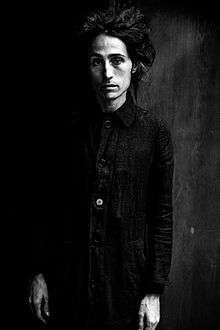Massimilian Breeder
Massimilian Breeder (born in Genova, June 13, 1978) is an Italian artist who works in film, drawings, sound and installation. He spent his childhood with his grandparents between Genova, Italy and Polperro, England. In 1992 he returned to Italy to study at the Paul Klee Institute for the Arts, followed by Neuroscience Studies at the University of Florence, where he began working on neural networks and biofeedbacks research, while developing interests in films and sculptural installations. He presented the first model of interaction between Cinema and Neuroscience at the prestigious Hôpital de la Salpêtrière in Paris, implementing the use of biofeedback technology to modulate and change the course of the narrative structure of a film. The project was titled Amigdalae and its development characterized Mr. Breeder's fascination with moving pictures. In 2002, he graduated with a degree in Experimental Psychology and began Cinema Studies at the National School of Cinema in Milan, which he would later abandon to move to New York City and work on his film projects * . Massimilian Breeder currently lives and works in USA.
Massimilian Breeder | |
|---|---|
 Massimilian Breeder | |
| Born | June 13, 1978 Genova, Italy |
| Nationality | Italian |
| Occupation | Artist, Filmmaker |
| Relatives | Nina Breeder |
Works
In 1998 Mr. Breeder began working on film, sound and installation under the form of ongoing projects like Wurlitzer Repetition (Ignite Arts Center, Los Angeles 2007). His collaborations with Nina Breeder * on New Reproductive Systems, films and installations received attention from The Pompidou Museum (Paris, France), Anthology Film Archive (NYC) and Guggenheim Museum (NYC). In 2008-09 his film Devil Come to Hell and Stay Where You Belong (2008)* obtained international interest and gave birth to a series of film works on the American Landscape. In his work Mr. Breeder explores elements of nature, employing narrative models from other domains, such as biology, geology, politics, characterized by concepts like restraint, fluids under pressure, violence and sexuality . In 2009, while working on a public installation "Crude Oil" in the Arabic neighborhood Darom - Tel Aviv, Mr.Breeder developed an interest in the Middle East and its endangered cultures and confines. During his extended stay in territories afflicted and transformed by ongoing conflicts, he wrote the film Reservoir, completed in late 2013. RESERVOIR*
Selected works and exhibitions
2014
- Fukushima Best-Girl: Writer and Director - currently in post-production
2013
- Reservoir: Writer and Director - Cicala Filmworks, NoCrew - IFC, ECT Commission
- The Car Crashes: Institute of Contemporary Arts Singapore exhibition Theo.do.lites - curated by Kent Chan & Silke Schmickl -
2012
2011
- Animal Kingdom: Schinkel Pavillon curated by April Lamm -
- Fukushima Best-Girl: Writer and Director - 2011 Japan, Film -
- Kinbaku: New York City, USA *
2010
2009
- Devil come to Hell and stay where You Belong: Pera Museum, Istanbul, Turkey
- Devil come to Hell and stay where you belong: Centre Georges Pompidou in Paris and Metz, France*
- Freeshout and Pecci Museum, Prato, Italy* Freeshout
- Anthology Film Archives, New York City* Anthology Film Archive
2008
- Love is a Burning thing: Full Scale Architectonic Installation, Darom Art Center, Tel Aviv (Crude Oil, Stone, 300x100)
- Artoteca, Milan, Italy
- Copenhagen International Film Festival, Official Selection* IMDB
- Gothenburg International Film Festival, Official Selection
2007
- The Lunch, Installation and Performance in collaboration with Nina Breeder at Art Space Blanque Monteaux, Paris
- "Wurlitzer Repetitions" Ignite Art Center (Lauren Bon), Los Angeles*
- Artist in residence at Cite' Culture at the Maison Internationalle de Paris, France
- "Naked", Triple Video Projection - Chelsea Museum
- "Untitledx" Life Size Installation - Saatchi Art London
2006
- Amigdalae - Art Basel, Miami
- Amigdalae - Hôpital de la Salpêtrière, Paris
- Boreas Gallery, Scott Laugenour, Brooklyn, New York
2005
- Video installation at Ex-Macelli Freeshout with Sislej Xhafa
References
- Experimental Cinema* LoWave
- Museum of Modern and Contemporary Art* Pompidou Museum
- Centre Georges Pompidou* Hors Pistes
- Anthology Film Archive, New York City* Anthology Film Archive
- The MainPOint* The Main Point
- Entrisme Contemporary Art Magazine* Entrisme
- Freeshout* Freeshout
- Internet Movies Database* IMDB
- Wurlitzer Repetitions *